Archive:Employment - quarterly statistics
Data extracted in October 2021
Planned article update: January 2022
Highlights
The second quarter of 2021 marked an important phase in the recovery of the European economy and labour market. This is the beginning of the general lifting of distancing measures generated by the health crisis due to the COVID-19 pandemic. Many EU Member States started implementing intermediary measures and announced the end, partially or entirely, of the financial assistance to businesses to mitigate the negative effects of the COVID-19 crisis on employment and businesses. In the second quarter, the rebound of the economy was initiated and clearly visible in the development of employment in comparison with the first quarter of 2021.
This article gives an overview of employment at EU level as well as in the EU Member States focusing on the two first quarters of 2021. The reference data result from the European Union Labour Force Survey (EU-LFS). It also provides for the first time an insight of the quarterly results collected on the employment of the first but also the second generation of immigrants. More commonly, this article depicts employment in general and specifically by gender, age, and level of educational attainment. A complementary analysis is dedicated to the temporary contracts and part-time work in the second quarter of 2021.
This article is part of the publication Labour market in the light of the COVID-19 pandemic.
Note: Please take note that figures presented in this article may differ in some cases from the source data due to continuous revision of the Eurostat database (Employment and unemployment (Labour Force Survey)).
Full article
Employment in upward phase, specifically for mid-age women
In the EU, employment of women aged 25 to 54 increased by 1.2 p.p., highest increase recorded from Q1 2021 to Q2 2021
In the second quarter of 2021, the share of employed people in the total population aged 20 to 64 reached 72.8 p.p.% after recording an increase of 0.7 percentage points (p.p.)) from the previous quarter (see Figure 1). The total employment rate hides a significant difference between men and women. While 78.3 % of men aged 20-64 are employed, women showed an employment rate of 67.2 %. Therefore, the gender gap amounted to 11.1 p.p. in the second quarter of 2020.
In the EU, slightly less than 1 in 3 young people aged 15 to 24 are employed (32.3 %). The male employment rate in this age group was 34.9 % against 29.6 % for women. Gender gap was narrower for young people (exactly 5.3 p.p.) than for the reference population (aged 20-64). Employment of men and women increased to the same extent between the first and second quarter of 2020 (+ 0.9 p.p. for both genders).
Around 8 in 10 people aged 25 to 54 were employed in the EU in Q2 2021 (80.3 %). The gender gap become wider in comparison with young people with a difference of 10.9 p.p. between the employment rate of men (85.7 %) and of women (74.8 %). The development between the first and the second quarter showed a noticeable difference between men and women. The employment rate of women increased by 1.2 p.p. against 0.8 p.p. for men. The lowest increases between the two quarters have been registered among people aged 55 to 64, the share of employed men as well as of employed women increased both by 0.6 p.p.to reach respectively 66.7 % and 54.0 %. Employed people in this age group also show the biggest gender gap compared to the other two groups with a difference between men and women of 12.7 p.p.
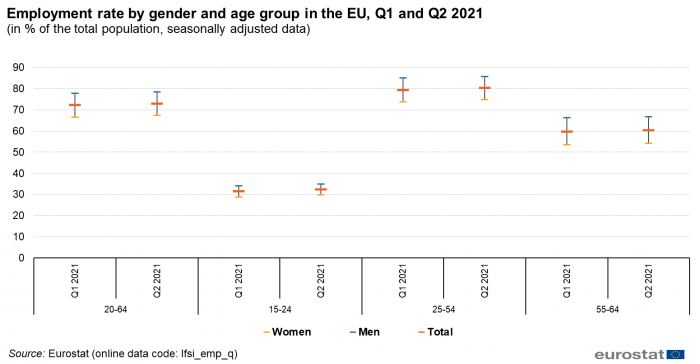
(in % of the total population, seasonally adjusted data)
Source: Eurostat (lfsi_emp_q)
Employment increased in 25 out of 27 EU Member States from Q1 2021 to Q2 2021
In order to provide an overview of the employment at national level, Figure 2 presents the employment rate of people aged 20 to 64 by country and gender in the second quarter of 2021, it also shows the level of employment in the previous quarter for the total population. This figure clearly shows that the employment rates are not homogeneous across the European Union, first between countries but also between gender in many EU Member States. In the Netherlands and in Sweden, more than 8 in 10 people aged 20 to 64 were employed (82.0 % and 80.8 % respectively) while the share of employed people stood below 70 % in Greece (61.2 %), Italy (62.0 %), Romania (66.8 %), Spain (67.2 %) and Croatia (67.8 %).
Comparing with the first quarter of 2021, the highest increases were reported by Slovenia (+2.8 p.p.), Greece (+2.1 p.p.), Belgium and Luxembourg (both +1.5 p.p.). Substantial increases, of more than 1 p.p., were also found in Sweden, Finland, Portugal and Ireland. The share of employed people also increased in France, Cyprus, Czechia, Bulgaria and Austria but to a lesser extent: the increases in those countries did not exceed 0.5 p.p. Only in two EU Member States (i.e. Estonia and Romania), the employment rate decreased from the first to the second quarter 2021 (-1.4 p.p. and -0.3 p.p.). In all EU countries, the share of employed men is higher that the share of employed women. Although the three widest gender gaps in employment are also observed among countries with the lowest employment rates, this relationship between both is not verified in all countries. The largest differences between the employment rate of men and women were found in Romania, Italy, Greece, Malta and Czechia, all showing a gender gap exceeding 15 p.p. Czechia and Malta showing relatively high employment rates, 79.4 % and 78.0 % respectively. In contrast, Estonia, Latvia, Finland and Lithuania recorded the narrowest gaps between men and women, all below 5 p.p. For comparison purpose, Czechia, the Netherlands and Malta reported the highest employment rates of men with respectively 87.1 %, 86.0 % and 85.8 % while the highest female employment rates reached in Q2 2021 were 78.2 % in Sweden, 78.0 % in the Netherlands and 76.3 % in Lithuania.
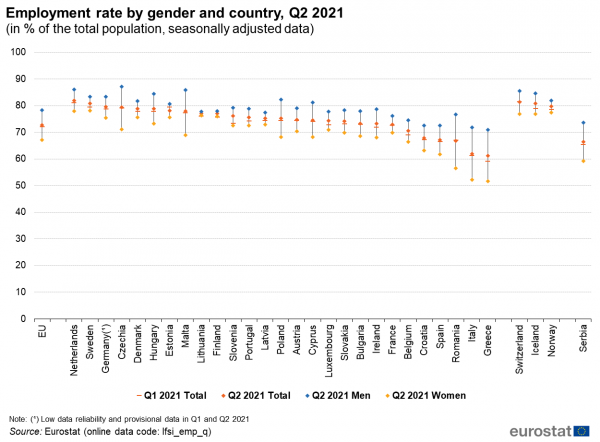
(in % of the total population, seasonally adjusted data)
Source: Eurostat (lfsi_emp_q)
Around half of people with low educational level in employment
Slovakia, Romania, Poland and Bulgaria recorded the largest employment differences between people with low and high educational attainment level in Q2 2021
Another way of looking at employment according the educational attainment level is to show the distribution of people in employment and in the total population according to the level of education as displayed in Figure 3. The objective here is to investigate if there are differences in the employed population in comparison with the total population (employed and not employed) as regards the level of education. Figure 3 presents these distributions for both men and women and for the total. In the whole population aged 20 to 64, around 1 in 5 persons had a low educational attainment level (20.3 %) but among employed people, only 15.0 % had a low educational attainment level so this category seems under-represented in the employed population. The low educational attainment level refers to the attainment of less than primary, primary or lower secondary education, at most. With respect to people with a medium educational attainment level (corresponding to at most upper secondary or post-secondary non-tertiary education), they show approximately the same weight in the population as well as in employment, 47.9 % against 47.6 %. People with a high level of educational attainment level i.e. tertiary education accounted for 31.7 % of the total population but for 37.4 % of total employment.
The largest differences were found among women with a low and high level of education. The share of women with a low level of education in the female population was 19.4 % but they accounted only for 12.3 % of the employed women. In the opposite, more than 40 % (42.5 % exactly) of employed women had a high level of education but looking at the total female population, they accounted for slightly more than one third (34.4 %).

(in %, people aged 20-64, seasonally adjusted data)
Source: Eurostat (lfsi_educ_q)
At EU level, the employment rate of people with a low level of education is 54.3 %, 72.4 % among people with a medium level of education and 84.8 % for people with a high level of education. As a matter of fact, the EU countries show very disparate employment rates with respect to people with a low educational attainment level. More than 60 % of people with low educational attainment level are employed in Portugal (68.7 %), the Netherlands (66.2 %), Malta (64.8 %), Cyprus (63.8 %), Germany (61.1 %), Luxembourg (60.6 %) and Estonia (60.3 %) but less than 45 % in Belgium (43.8 %), Croatia (43.4 %), Romania (41.7 %) and Slovakia (25.3 %). The largest differences between the share of employed people with a high and those with a low educational attainment level were found in Slovakia (59.8 p.p.), Romania (47.0 p.p.), Poland (43.4 p.p.), Bulgaria (43.0 p.p.), Croatia (40.9 p.p.) and Belgium (40.4 p.p.). Based on the most recent data, more than one third (34.2 %) of people aged 25-64 with a low education attainment level are actually between 55 and 64 years old. This category of people aged 55 to 64 represent 27.1 % of those with a medium educational attainment level aged 25-54 and 18.3 % of those with a high education level.
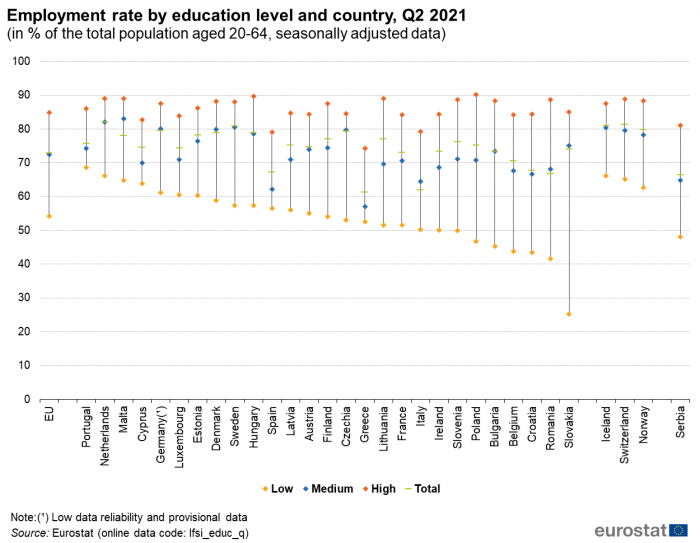
(in % of the total population aged 20-64, seasonally adjusted data)
Source: Eurostat (lfsi_educ_q)
Prevalence of temporary contracts among young employed people, part-time among women
One quarter of employed people in Spain had a temporary contract in Q2 2021
One relevant finding in the second quarter of 2021 refers to the share of temporary contracts (see Figure 5). Taking the population of employees as reference, temporary contract accounted for 13.0 % of employees in the EU. This share reached 24.7 % in Spain and 23.1 % in the Netherlands that means that almost 1 in 4 employees aged 20-64 were employed with a temporary contract in these two countries. This share was below 5 % in Slovakia (3.7 %), Bulgaria (3.2 %), Romania and Latvia (both 2.4 %), Lithuania (1.9 %) and Estonia (1.7 %). It also seems that there is no clear link between the level of employment and the share of temporary contract in a country, this means that a high or a low employment rate did not explicitly impact the share of temporary contracts in a specific country (see the attached excel file for further details).

(in % of total employees aged 20-64, seasonally adjusted data)
Source: Eurostat (lfsi_pt_q)
However, the disparity between the different age groups is very high. Almost 1 in 2 employees aged 15 to 24 (49.0 %) was under a temporary contract when it turned to around 1 in 10 (11.9 %) for people aged 25 to 54 and less (6.3 %) for people aged 55 to 64. Furthermore, the last quarterly results based on the Labour Force Survey show that the share of temporary contracts among young people (aged 15-24)is quite specific across countries. For example, it equals to or exceeds 60 % in Spain, which recorded the highest share with 69.4 %, in the Netherlands (66.6 %), in Slovenia (64.7 %), in Italy (61.7 %) and in Portugal (60.0 %) while temporary contracts in the total employees amounted to less 15 % in Malta (14.7 %), Slovakia (13.5 %), Hungary (13.2 %), Romania (8.8 %), Lithuania (8.7 %) and Bulgaria (8.5 %).

(in % of total employees, seasonally adjusted data)
Source: Eurostat (lfsi_pt_q)
More than 1 in 4 men working part-time would like to work more, this share drops to less than 1 in 6 among women working part-time
In all EU countries, more women than men tend to work part-time, Romania was the only exception to this pattern. At EU level, part-time employment concerns 28.4 % of the total employed women. Among employed men, the situation is drastically different as 7.6 % of men in employment worked part-time in Q2 2021. At EU level, 15.9 % of women working part-time in the second quarter of 2021 wanted actually to work more hours but among men working part-time, this percentage reached 25.6 %. Figure 7 shows the shares of men and women working part-time as well as the share of underemployed part-time workers in the total male and female employment. Both for men and women, the Netherlands ranked first with 62.7 % of employed women and 17.6 % of employed men working part-time. More than 3 in 10 employed women worked also part-time in Austria (49.9 %), Germany (48.0 %), Belgium (38.5 %) and Italy (31.3 %). This part-time working pattern was reported by less than 5 % of employed women in Slovakia (4.7 %), Romania (2.6 %) and Bulgaria (1.6 %). Regarding men, the highest shares of part-time workers in total employment, following the Netherlands, were recorded in Denmark (11.6 %), Sweden (11.2 %), Austria (10.8 %), Belgium (10.2 %) and Germany (10.1 %).
Among men, underemployed part-time workers, so part-time workers who want to work more accounted for more than half of part-time workers in Greece (66.0 %), Cyprus (58.8 %), Spain (56.8 %) and Croatia (53.3 %) but less than one fifth in the Netherlands, Slovenia, Denmark, Austria, Germany and Czechia. With respect to female part-timers, more than 40 % of them wanted to work more in Greece (54.4 %), Cyprus (47.8 %), Spain (46.2 %) and Croatia (42.9 %) while it concerns less than 10 % of women working part-time in Austria, Germany and Czechia.
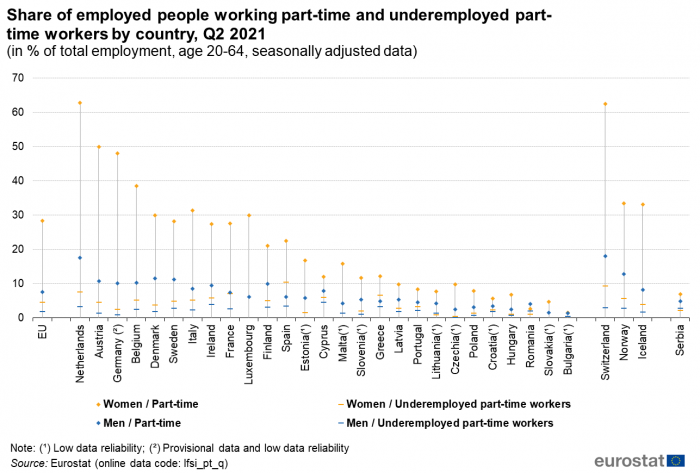
Source: Eurostat (lfsi_pt_q)
First and second generation of immigrants: education as critical factor
As newly released data, starting from Q1 2021, data based on LFS provide quarterly indicators on the employment of the second generation of immigrants. However, unlike the first sections of this article, data is not seasonally adjusted, this means that no corrections regarding the volatility due to seasonal effects have been applied.
At EU level, the employment rate varied quite significantly according to the migration status (see Figure 8). The highest employment rate is recorded by native-born people with mixed background, so those who are born in the country of interview (native born) and who have one foreign-born parent and one native-born parent. Indeed, slightly more than three quarters were employed in the second quarter of 2021 (75.1 %). They are closely followed by native-born people with native background who recorded an employment rate of 74.7 %. Native-born with foreign background (i.e. persons who are native-born, with both parents being foreign-born) had an employment rate of 71.0 % in the second quarter of Q2 2021. Furthermore, around two thirds of foreign-born people (66.5 %), so the first generation of immigrants, were employed at the same period.
Regardless the migration status, the share of employed men is always higher than the share of employed women but the difference can be more or less larger according to the migration status. The widest gender gap is reported by foreign-born people (16.9 p.p.) as a result of a male employment rate of 75.2 % and a female employment rate of 58.3 %. Rank second the native-born people with native background with a difference of 10.4 p.p. between men and women. The second generation of immigrants are those who had the narrowest gender gaps: native born people with foreign background recorded a difference of 7.6 p.p. between the employment rate of men and women and the native born people with mixed background showed the smallest difference i.e. 5.8 p.p. between men and women.
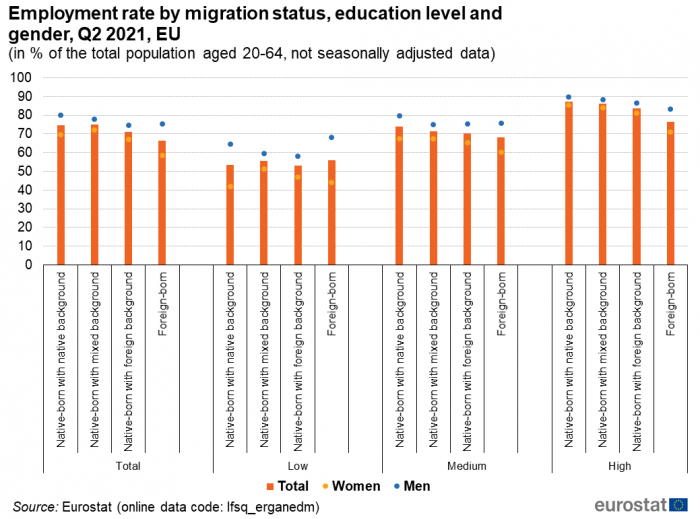
(in % of the total population aged 20-64, not seasonally adjusted data)
Source: Eurostat (lfsq_erganedm)
This basic description might be complemented by the level of education of each category (to what extent people are employed according to the migration stats and education level) together with the proportion of people having attained a low, a medium or a high education level by migration status (how many have such employment rate).
Among people with low educational attainment level, the foreign-born people so the first generation of immigrants registered the highest employment rate (56.0 %), followed by native-born people with mixed background (55.7 %), native-born people with native background (53.5 %) and native-born with foreign background (53.2 %). Significant gender gaps are reported by both foreign-born people and native-born people with native background, both having differences between the employment rate of men and women of more than 20 p.p. (respectively, 24.4 p.p. and 22.5 p.p.). However, this pattern is not observed for people with a medium or a high level of education, which deviate substantially. Native-born people with native background had the highest employment rate in both categories of education level (medium and high), respectively 73.8 % among people with a medium level of education and 87.4 % among people with a high level of education, followed by the native-born people with mixed background with respectively 71.4 % and 86.1 % for medium and high level of education, by native-born people with foreign background with employment rates of 70.3 % and 83.7 % and finally, the foreign-born people with 68.0 % and 76.6 %.
Figure 10 gives the distribution of people in the total population by migration status and education level. One third of foreign-born people (33.6 %) have a low level of education, this is more than the double of the share of native-born people with mixed background with a low level of education (12.0 %) and native-born people with native background (16.1 %). Moreover, almost 1 in 5 native-born people with foreign background have also a low level of education (18.7 %). Slightly more than half of native-born with native background and people from the second generation of immigrants have attained a medium education of level while it is the case of only 36.9 % of the foreign-born people. More than one third of native-born people with mixed background (37.7 %) have a high level of education, substantially more than native-born people with native background who are 30.8 %, foreign-born people (29.5 %) and native-born people with foreign background (29.0 %). No matter the migration status, women have more likely attained a high level of education and less likely attained a low level of education.
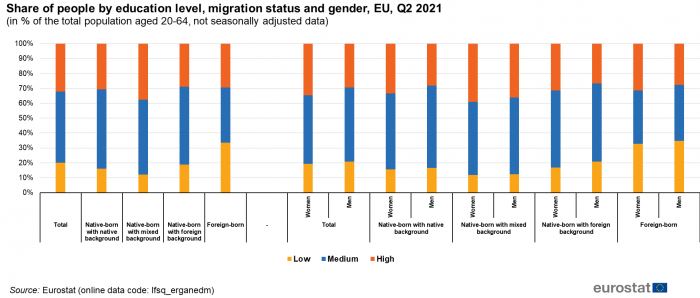
(in % of the total population aged 20-64, not seasonally adjusted data)
Source: Eurostat (lfsq_erganedm)
Based on 23 EU Member States for which data on native-born people with native and mixed background is available, the majority of countries (18 exactly) do not follow the EU pattern. In most of countries, the highest rate of employment was recorded by the native-born people with native background, followed by some of the other categories of migration status, as shown in Figure 10.

(% of the people 20-64, not seasonally adjusted data)
Source: Eurostat (lfsq_erganedm)
Source data for tables and graphs
Data sources
All figures in this article are based on seasonally adjusted quarterly results from the European Union Labour Force Survey (EU-LFS).
Source: The European Union Labour Force Survey (EU-LFS) is the largest European household sample survey providing quarterly and annual results on labour participation of people aged 15 and over as well as on persons outside the labour force. It covers residents in private households. Conscripts in military or community service are not included in the results. The EU-LFS is based on the same target populations and uses the same definitions in all countries, which means that the results are comparable between countries.
European aggregates: EU refers to the sum of the 27 EU Member States.
Country notes:
- In Germany, the whole microcensus has been used to estimate a restricted set of indicators for the four quarters of 2020 for the production of LFS Main Indicators. These estimates have been used for both the publication of German results and the calculation of EU and EA aggregates. By contrast, EU and EA aggregates published in the Detailed quarterly results (showing more and different breakdowns than the LFS Main Indicators) have been computed using only available data from the LFS subsample. As a consequence, small differences in the EU and EA aggregates in tables from both collections may be observed. For more information, see here. In 2021 Q1 only, data of one federal region, Bremen, is not included in the estimates, but national estimates are reweighted to respect population margins.
- Spain and France have assessed the attachment to the job and included in employment those who have an unknown duration of absence but expect to return to the same job once the COVID-19 measures in place are lifted.
Metropolitan France, also known as European France, is the area of the French Republic which is geographically in Europe. It comprises mainland France and Corsica, as well as nearby islands situated in the Atlantic Ocean, the English Channel and the Mediterranean Sea. In contrast, overseas France is the collective name for all the French-administered territories outside Europe. Metropolitan and overseas France together form the French Republic, referred to as "France" in the EU-LFS database.
Definitions: The concepts and definitions used in the Labour Force Survey follow the guidelines of the International Labour Organisation.
Different articles on detailed technical and methodological information are linked from the overview page of the online publication EU Labour Force Survey.
Seasonally adjustment models: Some of the EU-LFS based seasonally adjusted data published this quarter has been revised substantially. Indeed, the outbreak of the COVID-19 crisis actually lead to a major shock into the series. The impact of COVID-19 on a number of indicators have been explicitly modelled as outliers, and the combined effect of this shock and the new identification of the models explains the observed revisions. The methodological choices of Eurostat in terms of seasonal adjustment in the COVID period are summarised in the methodological paper: "Guidance on time series treatment in the context of the COVID-19 crisis". These choices assure the quality of the results and the optimal equilibrium between the risk of high revisions and the need for meaningful figures, as less as possible affected by random variability due to the COVID shock.
Context
The COVID-19 pandemic hit Europe in January and February 2020, with the first cases confirmed in Spain, France and Italy. COVID-19 infections have since been diagnosed in all European Union (EU) Member States. To fight the pandemic, EU Member States have taken a wide variety of measures. From the second week of March, most countries closed retail shops, with the exception of supermarkets, pharmacies and banks. Bars, restaurants and hotels were also closed. In Italy and Spain, non-essential production was stopped and several countries imposed regional or even national lock-down measures which further stifled economic activities in many areas. In addition, schools were closed, public events were cancelled and private gatherings (with numbers of persons varying from 2 to over 50) banned in most EU Member States.
The majority of the preventative measures were taken during mid-March 2020, and most of the measures and restrictions were in place for the whole of April and May 2020. The first quarter of 2020 was consequently the first quarter in which the labour market across the EU was affected by COVID-19 measures taken by Member States.
Employment and unemployment as defined by the ILO concept are, in this particular situation, not sufficient to describe the developments taking place in the labour market. In the first phase of the crisis, active measures to contain employment losses led to absences from work rather than dismissals, and individuals could not look for work or were not available due to the containment measures, thus not counting as unemployed.
The quarterly data on employment allows along the quarters to report on the impact of the crisis due to the COVID-19 pandemic on employment. This specific article focuses on the age and the level of education attainment of employed people in order to determine potential categories more or less affected by the economic downturn. It also shows the evolution of part-time employment and temporary contracts. Another article on the evolution of employment by occupation, sector of economic activity and professional status is also available in the context of the publication Labour market in the light of the COVID-19 pandemic.
Direct access to
- All articles on employment
- Labour market in the light of the COVID 19 pandemic - quarterly statistics
- Employment rates – annual statistics
- Job vacancy statistics
- Labour market statistics at regional level
- People outside the labour force
- The EU in the world - labour market
- Labour market slack – annual statistics on unmet needs for employment
- LFS main indicators (t_lfsi)
- Population, activity and inactivity - LFS adjusted series (t_lfsi_act)
- Employment - LFS adjusted series (t_lfsi_emp)
- Unemployment - LFS adjusted series (t_une)
- LFS series - Detailed annual survey results (t_lfsa)
- LFS series - Specific topics (t_lfst)
- LFS main indicators (lfsi)
- Employment and activity - LFS adjusted series (lfsi_emp)
- Unemployment - LFS adjusted series (une)
- Labour market transitions - LFS longitudinal data (lfsi_long)
- LFS series - Detailed quarterly survey results (from 1998 onwards) (lfsq)
- LFS series - Detailed annual survey results (lfsa)
- LFS series - Specific topics (lfst)
- LFS ad-hoc modules (lfso)
Publications
- EU labour force survey — online publication
- Labour Force Survey in the EU, candidate and EFTA countries — Main characteristics of national surveys, 2017, 2018 edition
- Quality Report of the European Union Labour Force Survey 2017, 2019 edition
ESMS metadata files and EU-LFS methodology
- Employment and unemployment (Labour Force Survey) (ESMS metadata file — employ_esms)
- Employment growth and activity branches - annual averages (ESMS metadata file — lfsi_grt_a_esms)
- LFS ad-hoc modules (ESMS metadata file — lfso_esms)
- LFS main indicators (ESMS metadata file — lfsi_esms)
- LFS series - Detailed annual survey results (ESMS metadata file — lfsa_esms)
- LFS series - detailed quarterly survey results (from 1998 onwards) (ESMS metadata file — lfsq_esms)